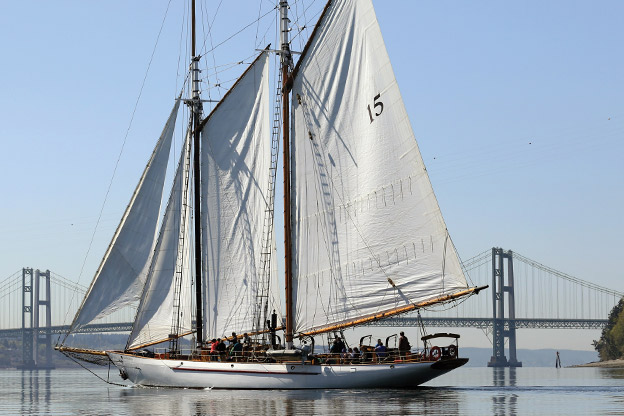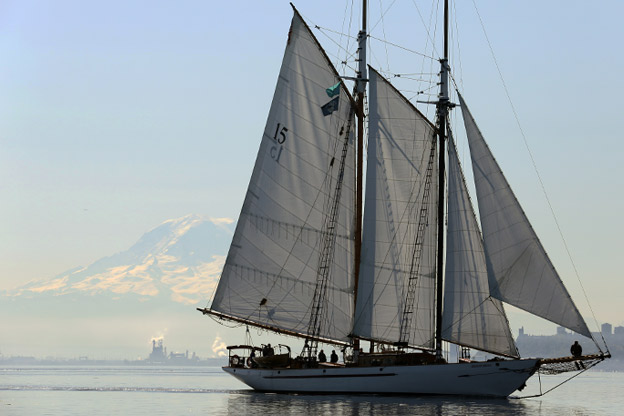Behind the scenes on the iconic Adventuress
Words: Lara Roché-Sudar // Photos: Jan Anderson
 If you’ve lived in and around the Seattle area any time in the past 50 years, you may have noticed a majestic tall ship plying the waters of Puget Sound like something out of a Patrick O’Brian novel. That ship was likely the Adventuress, a gaff topsail two-masted schooner commissioned in 1913 and designed by B.B. Crowninshield whose other designs include the yacht Witchcraft and schooner Martha. Originally hailing from the East Coast, Adventuress came to Seattle in the early 1950s and was designated a National Historic Landmark in 1989.
If you’ve lived in and around the Seattle area any time in the past 50 years, you may have noticed a majestic tall ship plying the waters of Puget Sound like something out of a Patrick O’Brian novel. That ship was likely the Adventuress, a gaff topsail two-masted schooner commissioned in 1913 and designed by B.B. Crowninshield whose other designs include the yacht Witchcraft and schooner Martha. Originally hailing from the East Coast, Adventuress came to Seattle in the early 1950s and was designated a National Historic Landmark in 1989.
Having never been aboard Adventuress, I decided to find out for myself: what makes Adventuress so special? I conducted some preliminary research and reached out to Catherine Collins, Executive Director of Sound Experience, who graciously invited me to attend the inaugural sail of the
2017 season.
I arrive at D Dock in Port Townsend’s Boat Haven at approximately 1000 hours on a Saturday morning, enjoying the bright morning sunlight and eager to climb aboard Adventuress for the first time. After checking in, I tour the ship with Captain Rachael Slattery, one of the rotating captains of Adventuress, while the lilting sound of bagpipes play in the background, courtesy of another of the day’s volunteer sailors.
“We try to make our programs as accessible as possible,” Captain Slattery says, “so fundraising is where we get most of our funding.” Sound Experience, which runs Adventuress’ many sailing programs, is holding their annual gala in the Seattle area during October where they hope to raise the last amount needed to finish a current restoration. The ship celebrated her centennial in 2013 and is in the midst of a five-year restoration, the capstone of which will be the deck replacement in the winter of 2017.
Every year from March to September, Adventuress can be seen all around Puget Sound conducting a variety of sailing programs. Day sails are offered almost every weekend during this time, where participants learn more about the ship and her mission as the environmental tall ship of Puget Sound. The Women at the Helm program is a five-day voyage for women ages 18 and up that travels from Seattle to Bellingham and includes a stop in Port Townsend for a special evening reception with wine and cheese. The Sound Studies are designed “to spark the imagination and foster an interest in science, leadership, maritime, and the environment” and can be reserved for school field trips or longer overnight group trips.
I start my tour in the main cabin, which Captain Slattery calls the heart of the ship because it’s the place where many of the crew and participants on overnight voyages sleep and where everyone takes their meals. The tiered bunks can be used for seats and the cabin is often a spot for community gathering, skits, presentations, or, in Captain Slattery’s words, a “beautiful silliness” that comes from sharing a space. She seems almost sad to say goodbye to the old deck, and looks fondly up at the beams over our heads. “I like to think of how much laughter and love is in this wood,” she says.
 In the galley, a diesel stove named Sadie runs 24 hours a day to feed the crew—as does the galley coordinator. “Everything on board has a name,” Captain Slattery tells us. The stove in the main cabin is called Lucy. According to Captain Slattery, they were named after infamous characters from the Bible—not for any religious reasons, just because of the fire element. Lucy and Sadie…well, I’ll let you figure it out.
In the galley, a diesel stove named Sadie runs 24 hours a day to feed the crew—as does the galley coordinator. “Everything on board has a name,” Captain Slattery tells us. The stove in the main cabin is called Lucy. According to Captain Slattery, they were named after infamous characters from the Bible—not for any religious reasons, just because of the fire element. Lucy and Sadie…well, I’ll let you figure it out.
The ship’s refrigerator is a part of Adventuress’s environmental mission, as it increases the energy efficiency of the ship; it’s made of layers of insulation, one of which is the same material used in the space station and uses the temperature of the water versus the air, which circulates 50-degree water rather than 80-degree air.
“There’s no such thing as a typical day on Adventuress,” Captain Slattery says. It’s an oft-asked question, especially from potential crew members, but what with the many programs that Adventuress participates in—one to two-day sails, overnight excursions, school field trips, programs like the upcoming Women at the Helm sail this June, or a coordinated sail with the Suquamish tribe—the crew’s days onboard Adventuress are quite varied. One staple of ship life is the morning and evening ritual of singing or reciting poetry. “We wake at 0700 hours, and it’s a quiet ship after 2200 hours,” Captain Slattery explains. During any of the overnight sails, crews are on anchor watch, and the upcoming watch is awakened by the crew coming off watch, usually with their names, the time, the weather conditions, and what they’re being awakened for. “You want to know who you are and why they’re waking you up!” When Adventuress is dockside, however, whoever gets up to make breakfast—usually the galley coordinator—wakes the rest of the crew up with a song or a poem. “It’s really nice and it’s something that’s been fun to bring back to my household,” says Captain Slattery.
After talking with Captain Slattery, I climb back on deck where everyone congregates around the helm. Two women sit on the deckhouse next to Catherine Collins, who introduces the pair as Dorothy Rogers and Charlotte Krebs, both of whom have been involved with Adventuress since she arrived in the Seattle area in the mid-20th century. They, like many of the other attendees, are long-time friends of Adventuress, and are here to share in her first cruise of the season.
The Edgewater Story
Dorothy Rogers, Ernestine Bennett, and their Girl Scouts loved to sail past the Edgewater Hotel in downtown Seattle because the reflection back from the windows when Adventuress was under full sail was spectacular. Dorothy says that one day Erni was sailing past the Edgewater and the boom was out a little too far. While none of the windows broke, the boom went ‘tap tap tap tap’ all across the front of the Edgewater Hotel. From then on, Dorothy and the Girl Scouts claimed that the big letter E on the front of the Edgewater stood for Erni.
Dorothy Rogers sailed as a junior in high school on a 76-foot catch from Anacortes to Victoria and back, because, in her words, “I had a great Girl Scout leader.” That Girl Scout leader left quite an impression, as an adult Rogers and her husband each led a scout troop, and she wanted her Girl Scouts to have as many opportunities and experiences as the Boy Scouts her husband led. The girls were eager to learn, and their only stumbling block was money. “The cookies just weren’t cutting it at all,” Rogers jokes. When sailing came up as the next step for the girls, “I contacted the fellow who had the Night Witch upon which I had sailed,” Rogers recounts to a rapt audience. Unfortunately, he had lost his ship off Alaska, but he gave Rogers the name of Monty Morton, who owned Adventuress at the time. This was in 1962, and Dorothy knew that Ernestine “Erni” Bennett in the neighboring town led a troop. If the two combined their troops, they might be able to raise the funds to afford the ship and all she entailed.
“Erni and I were so hooked on the ship,” Rogers says, “even though it was in terrible shape. No sprit, no extended boom, no tops’ls.” She passes around a photo of Adventuress as the ship had looked in the 60’s, and everyone makes deprecatory noises as we see how derelict she’d been.
“Can you tell us about the bus on the back?” Collins asks. “Is that a school bus?” In the picture, a light-yellow bus extended from just forward of the helm all the way to the foremast.
“I think Monty thought the kids would need a place to get out of the rain,” Rogers laughs. “He didn’t realize we’d come to sail.” In front of the bus was a circular room where Morton mounted a leather chair upon a riser so he could see out in all directions, and forward sat a large metal barrel that held the crew’s drinking water. Every night the Boy Scouts, who worked with the girls as they learned how to sail, would drum on the water barrel and sing along — it was how they knew when the ship needed more water.


